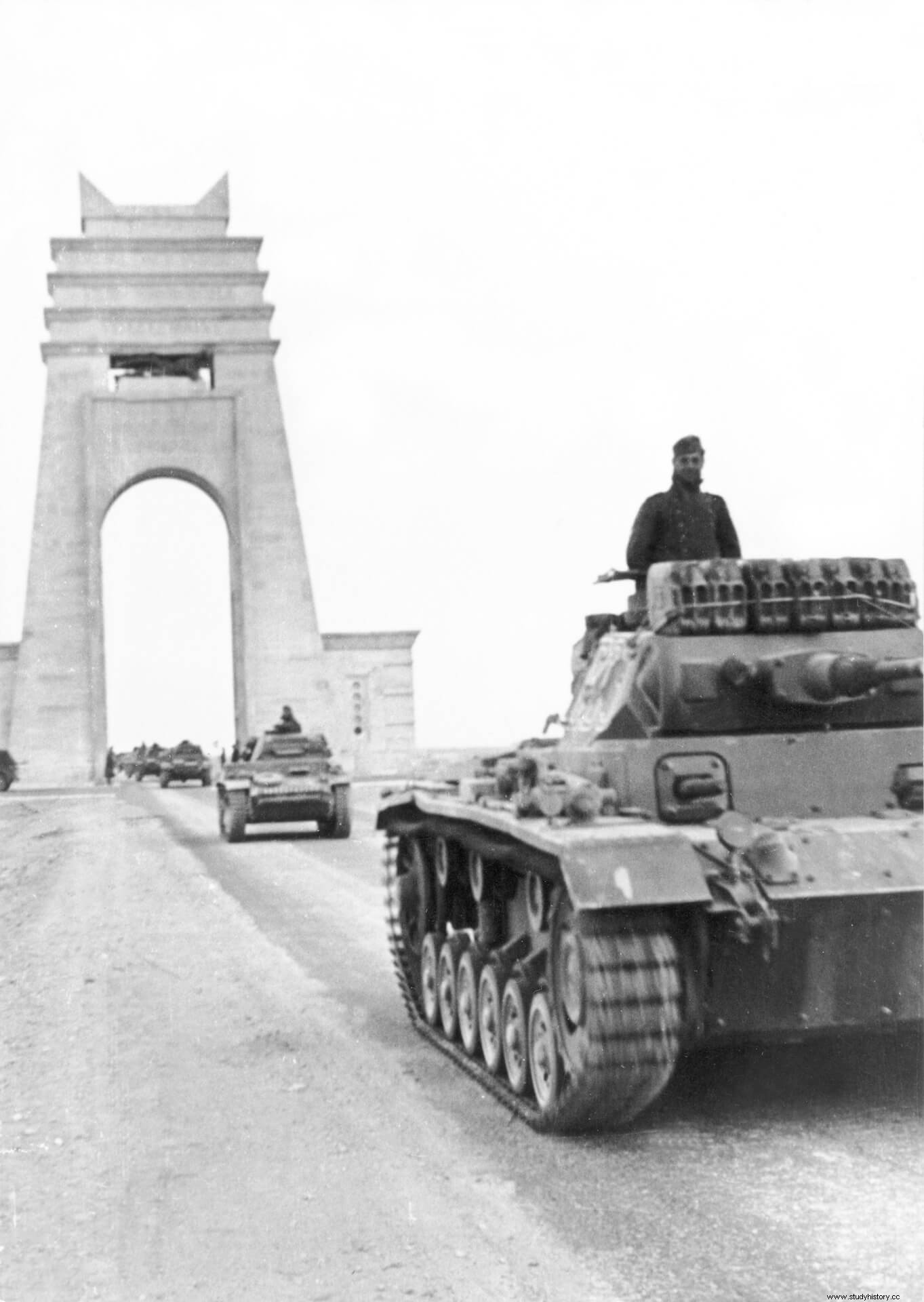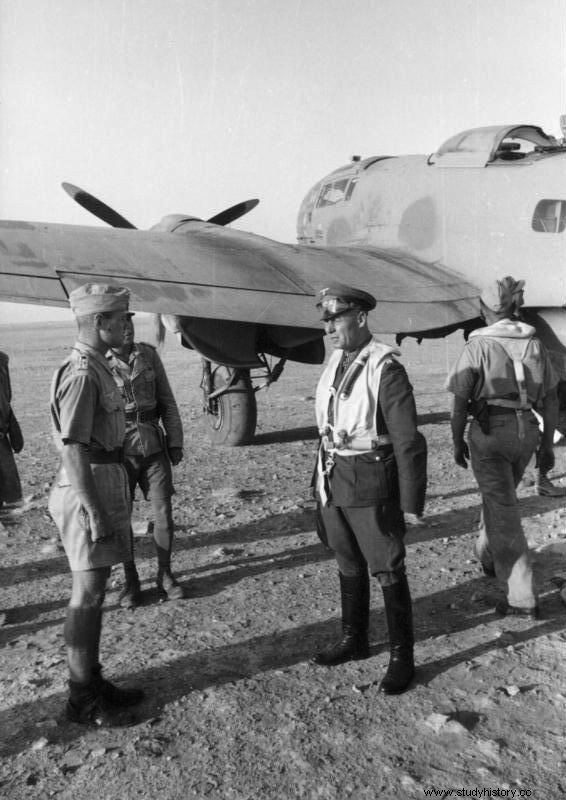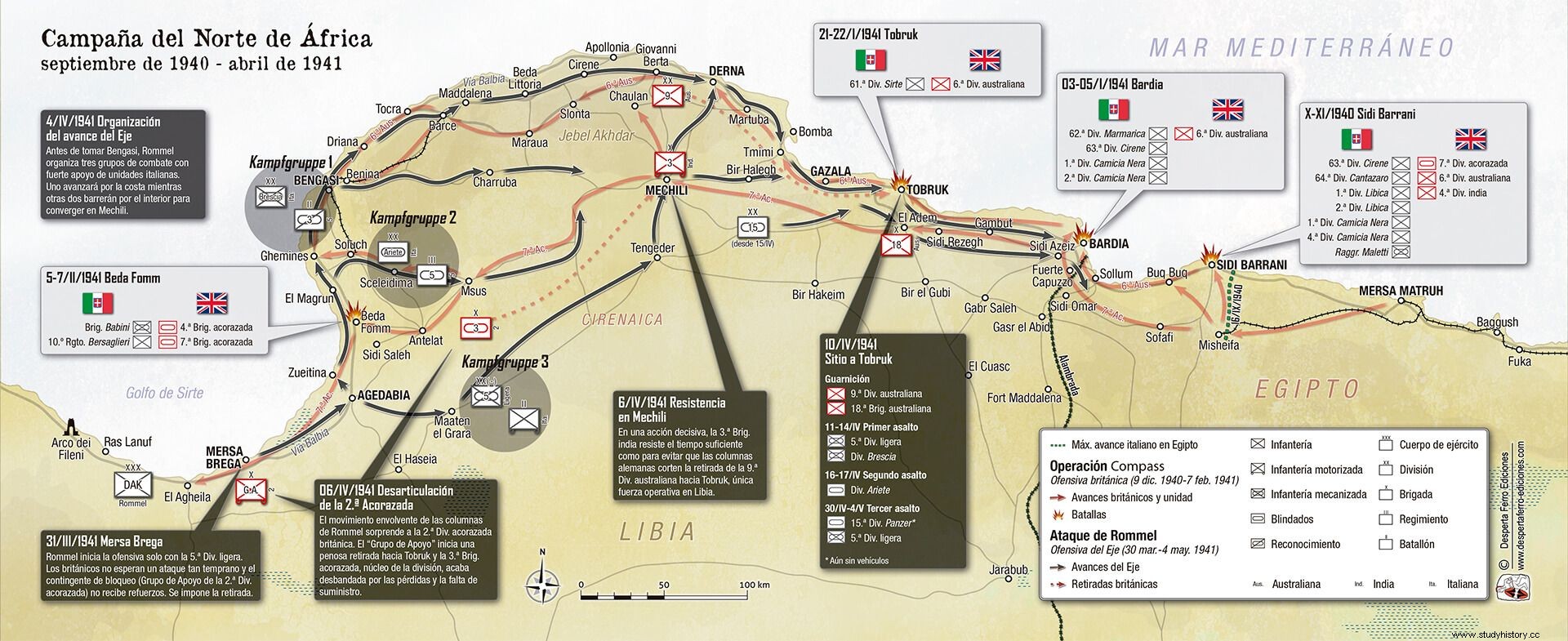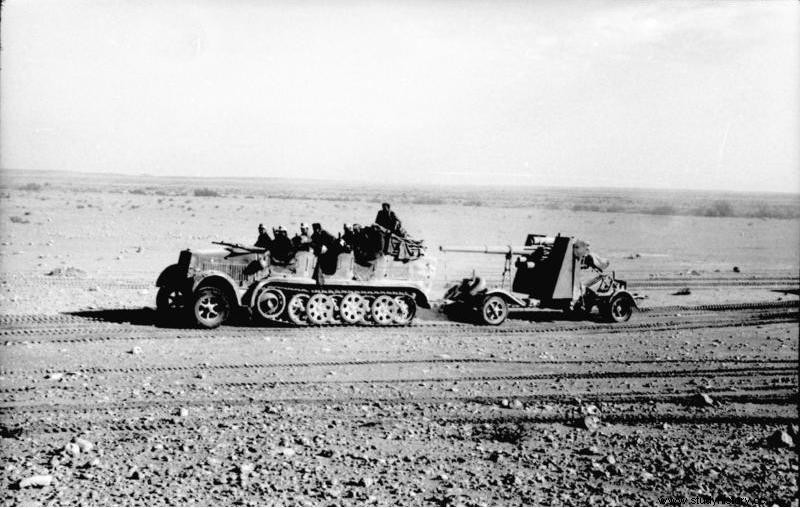
December 7, 1940 the RAF bombed Italian airfields as far as Tripoli. British Commander Richard O'Connor's attack, which began the following day, pitted his two divisions against nine Italian divisions. Despite their clear numerical inferiority , the British successively overwhelmed enemy fortresses supported by RAF attacks and the fire of the Royal Navy . Although the Italian artillery was used bravely, much of the infantry, poorly motivated and poorly led, surrendered or fled into the desert. The British advanced so quickly that even the most distant Italian garrisons were taken by surprise and sometimes surrendered without a fight. By Christmas 1940, the first of many columns of dejected Italian prisoners marched on Cairo, at a cost of 624 British casualties, along with six Blenheim bombers. and six fighters. The British victory he encouraged President Franklin Roosevelt to push the Lend-Lease Act through Congress in March 1941, but he also convinced Hitler to send in the Luftwaffe to the Mediterranean and order preparations for Operation Marita , the invasion of Greece and the Balkans, three days later.
Not content with cleansing Egypt of the Italians, Churchill ordered his generals to take advantage of the enemy confusion to advance on Cyrenaica , hoping that Libya would fall into his hands. The obvious route of advance was the Litoranea , also known as Via Balbia, the coastal road completed in 1937 that ran from Cairo to Tunis. However, the British were hampered by a lack of transport, the need to feed an unprecedented number of Italian prisoners of war, and the absence of forward air bases to support the offensive. Graziani left Sollum and withdrew with his four divisions to Bardia , but on the 4th the Australians pounced on them. Soon 40,000 stunned Italian soldiers were crammed into pens of barbed wire. The Australians added 456 casualties.
On January 21 the Australians conquered Tobruk , which yielded another 25,000 prisoners, 208 cannons, 87 battle tanks, and another 200 captured vehicles. British intelligence had discovered that the Italians had decided to leave Benghazi and on January 29, while evacuating Derna under British bombardment, O'Connor ordered the 7th Armored Division to execute a brilliant and reckless march across 150 miles of uncharted desert to cut off the coast road south of Benghazi to Tripoli , where 29 British Mark III Cruiser medium tanks They contained a hundred Italian tanks.
Historian Klaus Schmider has named Compass as "one of the most radically unequal military campaigns in modern history." Ten Italian divisions succumbed to the attack of two reduced British divisions. Nearly 130,000 soldiers were captured, along with hundreds of tanks, vehicles and guns, at the cost of 500 British killed, 1,373 wounded and 55 missing, and O'Connor was able to convey to his superior, Archibald Wavell:“fox hunted in open field ”.
The desert fox
The success of Compass fueled the urgency of German preparations to intervene in the Mediterranean, dating back to the summer of 1940. On January 11, 1941, Hitler ordered Operation Sonnenblume (“Sunflower”), the intervention of a “special blockade detachment” in North Africa, and on February 3 he explained his decision to the representatives of the high command of the Wehrmacht and the Luftwaffe to send an armored blockade force to Tripoli:Libya was irrelevant militarily, but its loss could jeopardize Mussolini's survival in power and free British troops to operate in southern France and the Balkans. The Luftwaffe would immediately intervene by attacking Malta to allow the 5th Light Motorized Division, under General Johannes Streich, to cross to Tripoli, followed by a Panzer division. . Hitler's first choice for "commander-in-chief of German troops in Libya", Erich von Manstein, was discarded in favor of Erwin Rommel , one of the heroes of the Battle of France, "who knows how to inspire his troops." On February 3, Rommel was summoned to Berlin from France, where he had been training his divisions for the invasion of England, and three days later he departed for North Africa via Rome with express instructions "not to engage troops." Germans in unnecessary battles. His orders were to establish a defensive line near Buyarat in the Gulf of Sirte and use his mobile troops to repel any outflanking attempts by the British. Rommel would be tactically subordinate to the Italian command in North Africa. On February 19 the new force of two divisions, christened the Deutsches Afrikakorps , consisted of 13,000 soldiers from the 5th Light Motorized Division, 18,000 men from the 15th Panzer Division and another 10,500 from the Luftwaffe .
Rommel was the quintessential risk-taking and combative soldier who, having mastered the principles of mobile warfare in France, he concluded that, as commander of the weaker army, he should stay on the offensive to survive. In his quest for a decisive battle through a bold and unorthodox maneuver, Rommel earned the respect and amazement of his opponents; however, he never enjoyed either in the army or among German historians the popularity that he still enjoys today in the Anglo-Saxon world. Although he undoubtedly possessed the instincts and operational virtuosity of a great field commander, his arrogant ambition combined with his inability, or disinterest, to recognize his strategic limitations jeopardized those indisputable gifts.

His player instinct, which also reached the politics, led him to join his destinies to that of the Nazi machinery as a way of rapid promotion for an officer who was neither Prussian nor Junker , nor a member of the prestigious General Staff, nursery of the German Generalate. The son of a school teacher, he shared Hitler's contempt for the Prussian aristocracy that held the upper ranks of the Army. In many respects, Rommel I was the wrong person to assume command in North Africa. His ambition and lack of diplomacy put at risk both Berlin's relations with the Italians and long-term German goals in the Mediterranean. Since Hitler was not in a position to provide the necessary resources in the Mediterranean to take them to Suez and the Persian Gulf, Berlin would have been better served by a less ambitious, less ostentatious and more cautious general to counter the Italian mistakes of February 1941. in the north of Africa. Given Hitler's obsession with defeating the Soviet Union, his reluctance to take risks in the Mediterranean, the weakness of the Italian allies, and the inability to conduct combined and joint operations in a maritime environment, the Wehrmacht It never had any real chance of threatening Britain's position in the Middle East, but Rommel's decision to go on the offensive helped revolutionize the significance of the war in North Africa and transform the Mediterranean into a crucial theater in the European conflict. Q>
The German objectives in the Mediterranean, limited to keeping Mussolini in power and confining the war to the North African coast, needed only to reach a stalemate, not a victory:capture Malta, adopt a defensive position in Tripolitania to shorten the supply line across the Mediterranean and North Africa, and transform the Western Desert into another "forgotten front," the Burma of the European theater. The ultimate Axis interest was to place the battlefield where fuel, sea power, and an almost impregnable base in the Nile delta tilted nearly all inherent strategic advantage to the British, and in that situation, the British would eventually prevail. just avoid being defeated. When the German military attaché in Rome, General Enno von Rintelen, complained that "Rommel was not a good strategist," he was expressing the view of the General Staff that, from the beginning, the main objective of the General Staff was to elevate its Own name. For the chief of the German General Staff, Franz Halder, the German objective should be the stabilization of the Libyan front in order to postpone the inevitable defeat of the Italians in North Africa until the war could be won in other theaters of operations. Rommel's operational success, which ended almost on the doorstep of the Nile delta, translated into a series of colossal incursions that placed Berlin in the worst possible strategic scenario in the Mediterranean:in the words of a prescient German high command report from 1941, he combined "the worst imaginable conditions for defense with the most complicated rear communications."
In the long run, Rommel's advance across the Mediterranean proved to be beneficial to the Allied cause. Its victories against disoriented, poorly trained armies that had yet to assimilate – let alone counter – the superior German tactical and operational system served as a catalyst both for the improvement of British war skills and for strengthening the Anglo-American alliance, pressured by a sense of urgency, and confirm Roosevelt's decision to send American troops to the Mediterranean in 1942.
Benghazi's second handicap
Newly arrived in Tripoli, Rommel began to claim more troops. German intelligence estimated that the British had 15 divisions in North Africa, while he had only two German and two Italian divisions under his command, with which he immediately headed for the Mugtaa Gorge, 700 km east of Tripoli. and only 40 km from El Agheila in British hands. Unaware in theory that the British were transferring troops from North Africa to Greece, Rommel was surprised and spurred on by his easy advance towards the limits of Cyrenaica. His ambitious imagination immediately conjured up the vision of conquering the Suez Canal, but Hitler was adamant that he limit himself to the local offensives necessary to protect Tripolitania. However, Rommel remained convinced that a defensive attitude was a self-defeating strategy that bought the British time. As of March 18, the reconnaissance of the Luftwaffe and the “Arab agents” informed him that the British were withdrawing from El Agheila and had left only a rear position in the Mersa Brega gorge. General Streich took El Agheila and advanced towards Mersa Brega on March 31, a day after British commander Sir Archibald Wavell reported that he did not see Rommel capable of attacking for another month. Rommel assigned every available truck to fetch fuel from the forward supply depot near El Agheila. The 5th Light began to snap at the heels of the retreating British and captured Agedabia on 2 April. With the 15th Panzer Division still landing in Tripoli, and after arguing with the Italian commander, General Italo Gariboldi, when he ordered a halt to the advance, Rommel took advantage of an ambiguous message from the Führer on April 4 to consider himself authorized to advance and to seize, in addition, the command of all the units in the combat front.

Rommel's advance, with the 5th Light Division and the Italian Ariete divisions and Brescia at the head, put the British in a delicate situation . "Enigma" message traffic, mainly from interceptions to the Luftwaffe , made it possible to trace the build-up of German troops in Tripoli and their forward deployment, but Rommel's intentions remained unclear. Therefore, the winning troops in Compass were withdrawn and replaced by inexperienced units British, Australian, New Zealand and Indian, who had also inherited a heterogeneous amalgamation of Italian M-13 tanks and as many British, of which only half were in operation. The Australians had so few transports that they had to abandon a brigade at Tobruk. Lieutenant General Philip Neame realized that he had only a fifth of the troops needed to defend Cyrenaica, as well as insufficient command equipment and transmissions to coordinate long-distance operations. But with the Royal Navy en route transporting four British and Australian divisions to Greece, Wavell told Neame that he "had nothing left in his pack" to offer him.
Indeed, Rommel's attack surprised the British before they could reinforce their forward defenses at El Agheila, while shortcomings in staff functions, communications, intelligence, logistics and armor made it difficult to organize an "elastic" defense. Despite the small size of his forces, Rommel's advance was unstoppable. As he advanced towards Benghazi Wavell had little information to dispel the optimistic operational assumptions on which the decision to go to Greece had been based. Intercepts of "Enigma" messages reported orders from Berlin urging Rommel to stand by. Unfortunately, the Italians had strengthened their codes and at this stage of the war the British were unable to decipher Wehrmacht transmissions. . In any case, the British collapse in Cyrenaica it was so explosive that, even if they had received intelligence reports, the troops would have been unable to take advantage of them.
Rommel's push in Cyrenaica unleashed what the British called the "second Benghazi 'handicap'" , usually equestrian, in which disadvantages are imposed on the best participants to equalize the chances of all). Wavell brought O'Connor back on 3 April for "advice" after losing confidence in Neame, dividing the British command and making his reactions improvised, indecisive and belated. Wavell erroneously believed that Benghazi could mark the limit of Rommel's advance, based on the imprecise calculation that Rommel would not be able to hold a large number of troops almost 1,100 km from Tripoli. Rommel further exploited the enemy embarrassment and built false decoy tanks on Volkswagen vehicles to make British aerial reconnaissance believe he had a large armored element, and he used every available truck in a supply chain to the Arco dei Fileni (the Arch of the Filenes), his forward depot in Tripolitania, to stock up on fuel and supplies. For his part, Wavell's failure to establish forward fuel and ammunition depots led to him having to abandon many tanks. Demonstrating operational flexibility German, Rommel divided his troops into four columns, three of which advanced inland across the Cyrenaica elevations to converge at Mechili, while the fourth, composed of the Brescia Division , pursued the retreating British across the coast road.
Rommel planned to regroup his scattered forces at Mechili to later progress towards the coast between Derna and Tobruk to cut off the retreat of the British troops through the Via Balbia. Rommel directed, coordinated and reprimanded his column commanders from a Storch plane. as they trudged through Cyrenaica. Lack of fuel, navigational errors, mines, overheating engines in temperatures reaching 50º, and incredibly rough terrain scattered and delayed the advance of their troops, making the Luftwaffe to support or protect them from sporadic attacks by the RAF . On April 8, one of his columns cut off the Via Balbia at Derna, though too late to intercept the retreating Australians who fled to the concrete and hawthorn sanctuary of Tobruk. In fact, the British proficiency in withdrawing and reaching Tobruk was Wavell's only achievement of the campaign. But the commanding officers, Neame and O'Connor, were not so lucky:lost in the desert, they headed for a German battalion and were captured. The Germans also captured the commander of the 2nd Armored Division, 60 officers and 1,700 men, plus a large amount of equipment, as they tried to escape to Mechili. Derna He offered Rommel the supplies of water and fuel that enabled him to continue his advance. Confirming the Germanic adaptability and genius for improvisation, Rommel again reorganized his troops into a battle group combining elements newly arrived from the 15th Panzer with the 5th Light and sent it towards Tobruk which, according to his intelligence, was poorly defended. He decided to attack, taking the numerous British ships in his port as an indicator that the garrison was being evacuated. In reality, the ships in the port of Tobruk they were landing reinforcements which included tanks, artillery, and anti-tank and anti-aircraft guns. The breakneck recapture of Cyrenaica, which in little more than a week had claimed two of the highest enemy commanders and a divisional commander, left the British baffled. Churchill demanded that Tobruk hold, so Wavell began redirecting reinforcements planned for Greece there. The commander of the 9th Australian Division, General L. J. Morshead, a Gallipoli veteran, quickly organized the defence. The Western Desert Force, the seed of the future 8th Army, was hastily amalgamated from two incomplete divisions and a Guards brigade to hold the Egyptian border. If Wavell was finding it difficult to concentrate trying to simultaneously manage the fighting in Ethiopia, Eritrea and Greece, while keeping a close eye on a budding rebellion in Iraq, the impressiveness of his progress made believe Rommel that he was reliving the fall of France. Drunk with victory, he failed to assess the growing British resistance and was also unprepared to tolerate excuses from his subordinates. On the contrary, he rebuked and outraged those who requested ammunition, fuel, or time to repair their vehicles and give rest to his exhausted soldiers. He needed Tobruk because he blocked the Litoranea , his route to the Nile, which his troops had renamed the Rommelbahn . Possession of the port from him was also vital to maintain the momentum of the advance, but above all, he needed Tobruk to satisfy his ego. He made his headquarters in an Italian trailer set in a deep ravine, relatively invulnerable to air attack, and visited the front lines in a captured British armored command vehicle, a windowless hulk sitting on huge tires he called his Mammoth . Rommel's decision to conquer Tobruk In addition to being consistent with his instinctive running of the campaign, it was not illogical. As in the French campaign, he was counting on the disorganization of the defenders for victory. The Morshead garrison numbered some 36,000 men, approximately two-thirds of whom were combat troops and the rest a sum of refugees, base personnel and prisoners. The exhausted soldiers of him barely had time to get acquainted with the almost 50 km of defensive perimeter, from which the infantry battalions were assigned an 8 km front. However, after almost a month of fierce fighting (from April 11 to May 4) the British managed to hold Tobruk . Churchill understood that Operation Sonnenblume had spent his last cartridge, but to prevent Rommel from retaking the initiative he took the risk of ordering the Tiger convoy of six fast transports escorted by the Queen Elizabeth to cross the Mediterranean between May 6 and 12 with 300 tanks and 53 Hurricane fighters . The battle for North Africa would drag on for another two years. Rommel continued to dazzle operationally and successive British commanders who underestimated him paid a terrible price, but as Paulus made clear in his Sonnenblume conclusion report addressed to the high command of the Wehrmacht in Berlin, “the key in North Africa is not Tobruk or Sollum, but the organization of the supply ”. But Axis logistics were too fragile to sustain the exchange of offensives in North Africa. Meanwhile, the British, with the support of the United States, assembled a solid infrastructure to sustain the North African campaign. The allied armies had much to learn, but the material factor and logistical superiority would gradually wear down the Deutsches Afrikakorps .
Bibliography
This article was published in Desperta Ferro Contemporánea nº 4 as a preview of the next issue, the Desperta Ferro Contemporánea no. 5:Deutsches Afrika Korps.
